This post contains affiliate links, which earn revenue for this site at no extra cost to you. See my disclosure policy here.

Over in the Frugal Girl Facebook group (Click here to join! I approve readers promptly.), reader Karen was asking for tips about cooking chicken breasts, since hers often turn out rubbery or chewy.
So, I thought I’d put together a list of my best tips for good chicken breasts.
1. Use a meat thermometer.
This is my single best tip. If you do nothing else, buy an instant read thermometer.
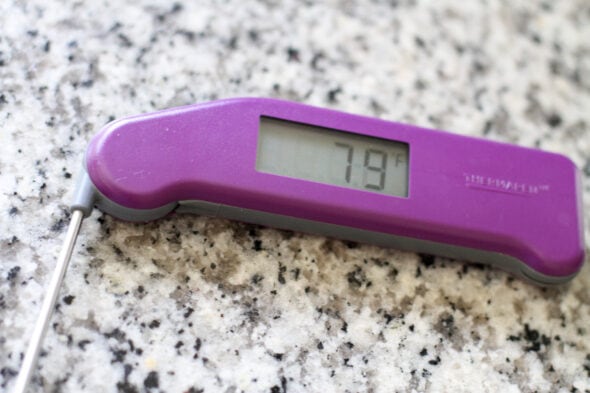
A lot of people overcook their chicken because they are scared of food poisoning (Understandable.)
A thermometer will help you cook your chicken JUST until it’s safe rather than 50 degrees past safe, which brings you into the Land of Dry and Chewy Chicken.
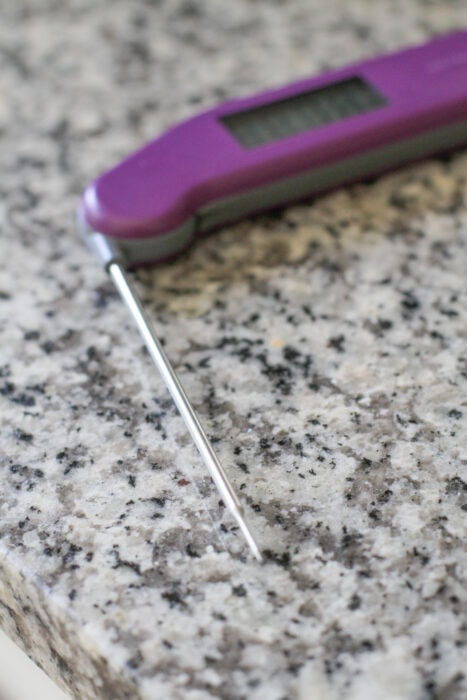
Cook your chicken breasts to 160-165°F and no further!
I got the classic Thermapen for Christmas a few years back and I use it multiple times every week.
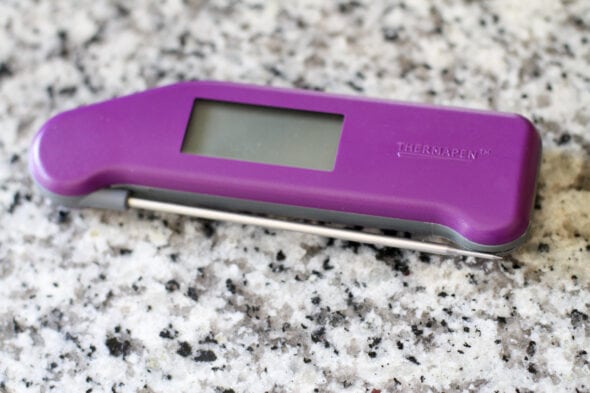
I’d spring for the Mk4 if I were shopping now, or if you want a budget model, try the $35 Thermopop.
I know even $35 might feel like a lot, but I think it’s worth it. Skip a night or two of takeout and spend the money on a good thermometer that helps you make delicious food at home!
(I’m not affiliated with Thermoworks in any way, as they’re not sold on Amazon. I just love my Thermapen and it’s way outlasted the cheap digital thermometers I had in the past.)
2. Use a hot pan for a good sear.
I usually heat a little oil or bacon grease in a pan until it’s nearly smoking and then I add my chicken.
This gives the chicken breasts a nice golden sear on the outside, which makes them taste (and look!) delicious.
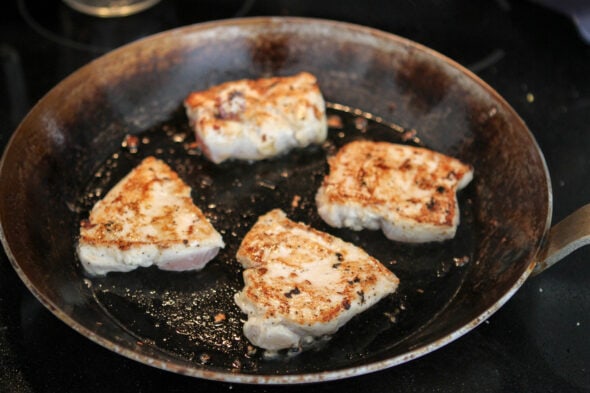
A Frywall is pretty handy to use for this, to help keep your stovetop from getting spattered.
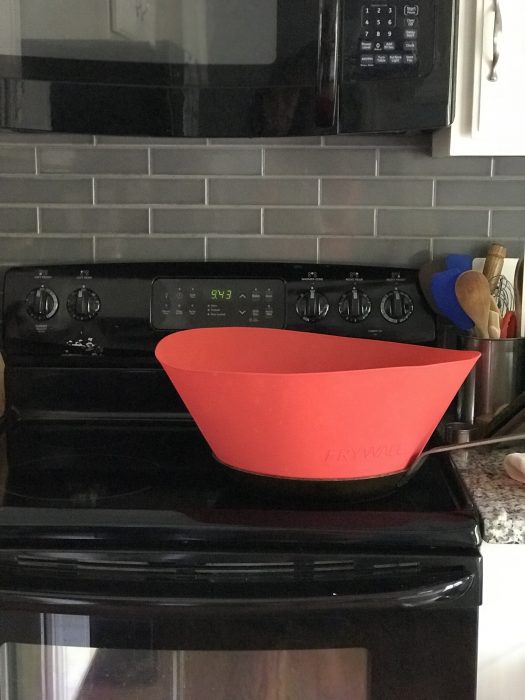
(Here’s my post all about the Frywall.)
3. Try a brinerade.
The editors at America’s Test Kitchen/Cook’s Country/Cook’s Illustrated are big fans of a brinerade, which is sort of a mix between a marinade and a brine.
It’s basically just a salty oil mix, and it makes a big difference in how juicy and flavorful your chicken will be.
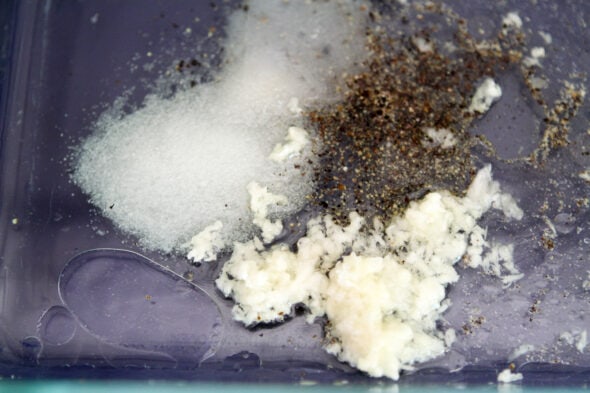
Here’s the best basic chicken brinerade, which uses pantry ingredients you probably already have!
4. Cut your chicken breasts up.
Unless you buy organic chicken breasts, the ones in stores these days tend to be enormous.
And it’s a little hard to cook something like that thoroughly without drying it out.
So, I pretty much always cut my chicken breasts up into three pieces.
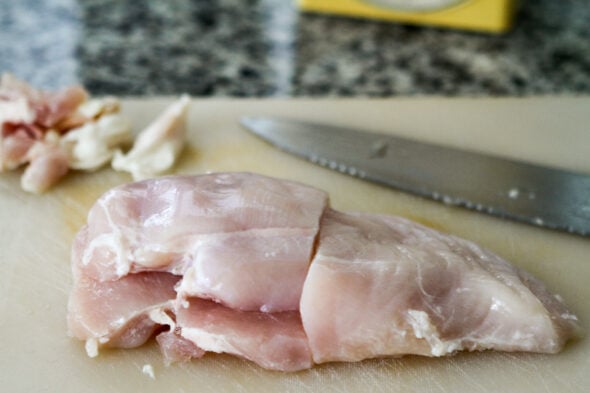
I’ve been doing this for years, but handily enough, the latest Cook’s Illustrated magazine had a drawing of exactly the method I use.
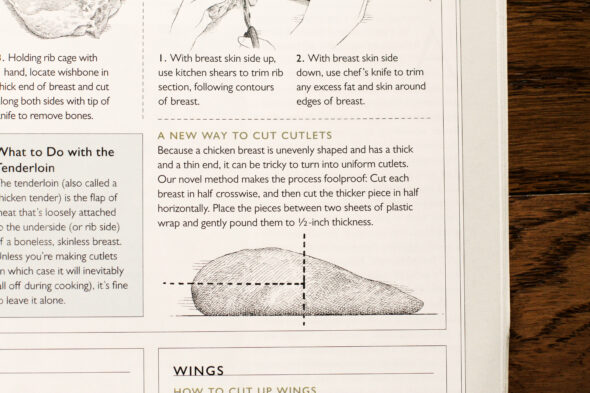
Except I usually don’t bother with the pounding.
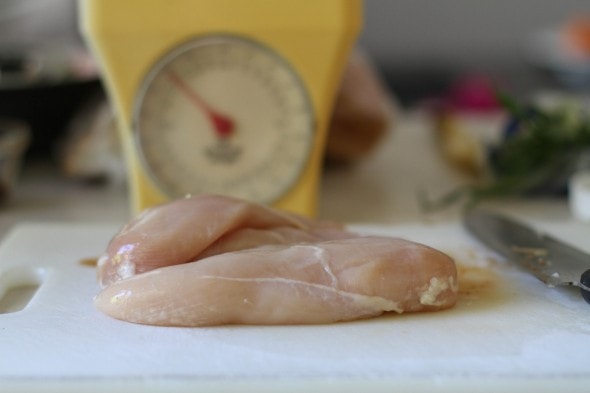
5. Let your chicken rest before you cut it up.
Even if your chicken is cooked properly, it’ll be a little dry if you cut it up right away.
Letting the chicken rest will ensure that the juices stay IN the meat, rather than running out onto the plate.
For a piece as small as a chicken breast, a short 10 minute rest should do the trick. Even a five minute rest is better than no rest at all.
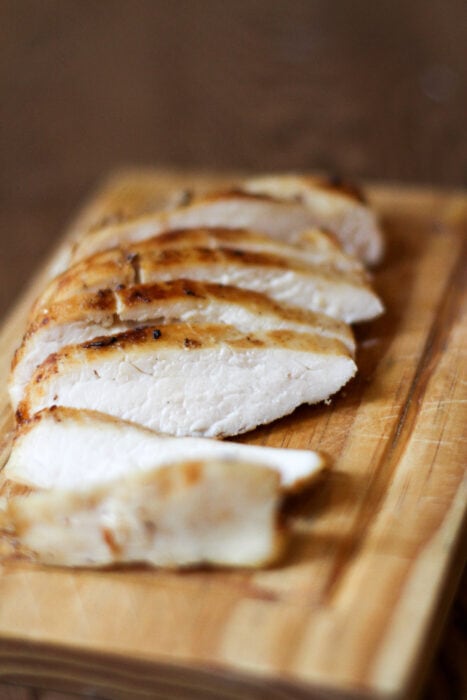
Let me know how your chicken comes out once you try these tips!

Sherrie
Wednesday 4th of September 2019
This is one of the best posts ever, thank you
Natalie
Thursday 22nd of August 2019
I recently came across this method for cooking moist chicken breasts on pinterest that works wonders. Season the chicken however you like, place on a baking sheet and cover with parchment paper closely around the chicken. Bake at 400 degrees for 20-40 minutes depending on the size. The actual "recipe" I follow is here: www.thekitchn.com/how-to-cook-the-best-chicken-breasts-in-the-oven-cooking-lessons-from-the-kitchn-211453
Shirley
Thursday 22nd of August 2019
I intend to try the brinerade and all these tips, but I have a question or two. I do sear my chicken but perhaps too much and don't turn down the heat soon enough. Is that like a minute each side to sear and then turn the heat down to medium, or lower (?) and do you cover at this point. I would use my thermometer but is this about 10 minutes more? My son "fries" chicken for chicken and stuffing and it never gets a sear and is always good. I don't know how he does it. I've intended to try the buttermilk soak but never remember to get it--at least I have brinerade ingredients on hand. That cut up technique looks good. I have trouble cutting a whole long strip evenly. BTW, if organic chicken is still the way chicken has "always" been, it's sort of an unsettling thought as to how/why today's chicken breasts are so huge. Now a harder question, do you know the secret to cooking pork chops. My chicken is good sometimes but I've nearly given up on pork chops.
Kristen
Thursday 22nd of August 2019
The biggest pork revelation for me was about temperature! I wrote about it here: https://www.thefrugalgirl.com/52-new-recipes/
The amount of time needed to cook the chicken breasts all depends on the thickness of them and also how much sear you like. I often keep mine on medium high heat for several minutes on each side before turning down the heat.
WilliamB
Thursday 22nd of August 2019
It's different for fat pork chops than for thin pork chops.
For fat pork chops (or any other thick slice of meat): - salt & let rest for 30-60 min - bake at 325F till they are almost your desired doneness - sear in well-heated pan (cast iron works very well) over high heat to get a crust - let sit 10-15 min before cutting
For thin pork chops: - salt & let rest 30-60 min - cook over high heat till a bit short of your desired doneness, turning frequently to prevent burning - let sit about 10 minutes before cutting
Jennifer
Thursday 22nd of August 2019
I tried the brinerade yesterday and posted a comment about it. Long story short, we had delicious chicken even though I over cooked it a bit! I have a meat thermometer but I rarely use it. I do frequently over cook my chicken because I get busy doing other things.
Jennifer
Thursday 22nd of August 2019
Also, I often buy boneless-skinless chicken thighs because they rarely are dry no matter how I make or neglect them.
M
Thursday 22nd of August 2019
I totally agree that the thermapen is worth the extra money. After years of cheap instant read thermometers I realized I’d spent the cost of a thermapen on $15 thermometers that broke repeatedly. So I sprung for the MK4 and I LOVE it. Top kitchen buy ever.
Jenny
Thursday 22nd of August 2019
I have the same cheap digital instant-read thermometer (Pyrex brand, probably from BB&B) that I’ve had (& used frequently) for more than 20 years! It works great! I’ve replaced the battery only once! I guess I’m very lucky! Although when I bought it, I bet it was under $10, but it felt like a splurge because of a very limited budget. It helps with all meats. I especially had trouble gauging big roasts and turkeys done-ness. I would naturally way over-cook things. My Mom was afraid of trichinosis and such.